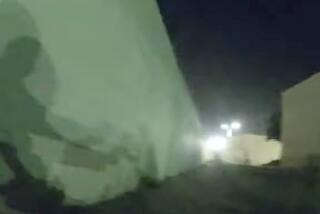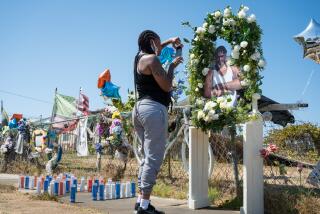Prosecutors Release Deputy’s Account of Fatal Shooting : Law enforcement: In an effort to clear lingering public doubts about the handling of the case, Brian Scanlan’s description of events leading to his colleague’s death during a training exercise is revealed.
- Share via
SANTA ANA — For all the candlelight vigils, all the protests, all the legal maneuverings that have followed the shooting death of Orange County Sheriff’s Deputy Darryn Leroy Robins three months ago, one element has remained absent from the public debate: the account of the veteran field training officer who shot Robins to death outside a Lake Forest movie theater.
But that piece of the puzzle emerged this week as Orange County prosecutors, hit by charges that they had not pursued the case aggressively enough, released virtually all their evidence on the shooting, two weeks after a grand jury rejected their recommendation and decided not to indict Brian Scanlan.
It is Scanlan’s interview with authorities just hours after the shooting--describing the lull of a Christmas morning, the emotional rush of getting ready for a mock confrontation with a Los Angeles gang member and the shock of seeing his colleague spitting blood like “a hose”--that fills in many of the missing details in the case for the first time.
Scanlan said he was not expecting any trouble as he prepared to pull over his training partner for an impromptu drill behind the theater that Saturday afternoon.
A few months earlier, Scanlan said, he had learned that he needed to work on keeping his finger off the trigger of his service weapon. During video exercises at the so-called “laser village” at the Sheriff’s Department’s training academy, he had mistakenly “shot” two people.
Even so, Scanlan acknowledged, he was feeling “cocky” as he prepared to run through the drill, anxious to show that he could meet any challenge his partner threw at him.
He and fellow deputy Robins were developing ways to counteract new techniques that Los Angeles gang members had been using to get the drop on cops. Scanlan said he figured that if the gangbangers were up to new tricks, “I want to know.”
Robins, playing the role of a suspect in a car stop, was going to show him something new.
Slowly, the nine-year veteran approached Robins’ car with his loaded 9-millimeter handgun drawn. Robins started talking back to him, demanding to know why he was stopped. Robins’ hands were jittery, “going all over the place,” as he handed over a white piece of paper marked “CDL,” meant to represent a California driver’s license, Scanlan recounted.
Then, supposedly responding to a request for his vehicle registration papers, Robins reached up behind the driver’s side sun visor and produced an unloaded .25-caliber handgun, thrusting it out the window, Scanlan said.
Startled, Scanlan “jerked back,” he said, and fired a single Talon bullet into his colleague’s face. Half an hour later, Robins was dead.
Scanlan’s gripping yet strikingly unemotional narrative of what took place behind the theater is the keystone of two months of interviews, forensic reports, videotapes, photographs and other evidence released to the news media Wednesday by the district attorney’s office.
The volatile shooting case has attracted considerable attention, fueled in part by charges from black and Latino groups that the case was not handled properly by authorities because the dead deputy was black and the one who shot him is white.
Yet despite heightened racial sensitivities, many details of the case remained the subject of speculation and off-the-record comments--until Wednesday.
Assistant Dist. Atty. John Conley said prosecutors took the unusual step of releasing almost everything in their investigative files in hopes of dispelling lingering suspicions that the shooting was not accidental--or that Robins’ race was somehow a factor in the case.
Prosecutors refused, however, to allow copying or television broadcasting of any of the key videotapes in the case. And even as they allowed reporters to view the tapes in a crowded Santa Ana office, they edited out certain key scenes--such as the one showing Robins’ fellow deputies frantically carrying him from a patrol car into the emergency room.
Nonetheless, the newly released evidence provides for the first time a detailed chronology of the day’s events. And it is Scanlan’s 90-minute account, given to investigators just hours after the shooting, that authorities say has become the most authoritative version.
In more than 40 interviews after the shooting, “nobody’s contradicted anything” that Scanlan related, Conley said. “All the other little details fit.”
More to Read
Sign up for Essential California
The most important California stories and recommendations in your inbox every morning.
You may occasionally receive promotional content from the Los Angeles Times.














